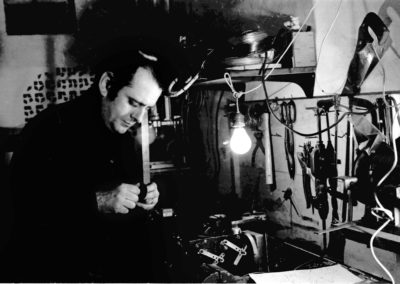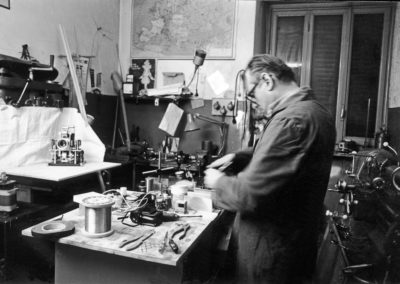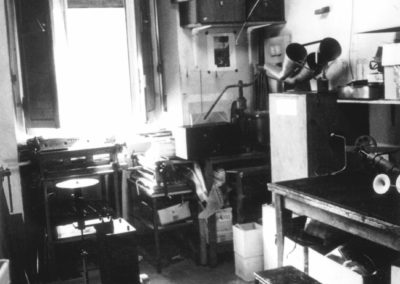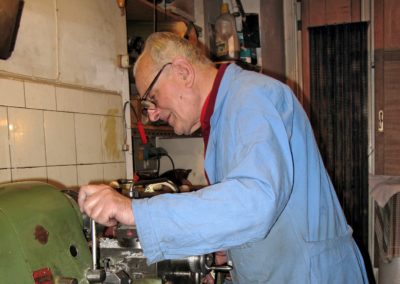Piero Fogliati's studio
Fogliati’s studio-laboratory in Turin, which has many affinities with Calder’s famous studio, is a place where concepts are transformed into results, matter into form.
When you go there for the first time, the initial impression of an electromechanical laboratory is immediately erased by the unmistakeable presence of the artist, an authentic homo faber who transforms the reality of the studio.
Surrounded by projectors, compressors, lenses, electric cables piled up around a large lathe and a grinder, as well as sheets of brass, aluminium and steel, Fogliati is sure-footed; he attaches electrical plugs, presses switches, and, above all, he talks, clearly and enthusiastically, about the piece he is about to show you. Your curiosity rises, and suddenly, in a corner of the studio, out of this jumble of technological components, an immaterial light or sound event takes place, creating a sense of poetry and magic. Meanwhile, he describes the various stages of the project that produced the perfect marvel unfolding before your eyes.
Mirella Bandini – 1990
Introduction to a degree thesis on the work of Piero Fogliati
The first time I entered Piero Fogliati’s studio, I felt disoriented. What was I expecting to find? I already knew one of his pieces, the evocatively titled Edicola delle apparizioni (kiosk of apparitions), but obviously this was not sufficient preparation. Even if you are familiar with Fogliati’s creations, the first encounter with his work environment is a unique experience.
The second time everything already falls perfectly into place. Perhaps the stereotype of an artist’s studio full of canvases, brushes, easels and paints is misleading; there is none of that here. On the contrary, you feel you are in the laboratory of someone accustomed to the precise mathematical solidity of mechanical and technological construction. In other words, what strikes you is not so much the idealistic atmosphere typical of an artist’s activity, as the rigorous pragmatism of an impeccable constructor.
Even so, great caution should be taken in saying this, because such a sharp distinction cannot be made about Piero Fogliati. He is an artist in the full sense of the word, but he also has an equally important quality that makes him a point of convergence between two fundamental activities in man’s existence: art and science.
Alessandro Trabucco – 1999
A laboratory for the senses and the mind
A visit to Piero Fogliati’s studio is an unforgettable experience.
A small entrance, three rooms in semi-darkness where you move with difficulty through a tangle of cables, equipment and mysterious devices.
A chimeric combination of an auto electrician’s garage, a mechanical workshop, an ironmonger’s shop and a basement packed with technological relics.
But just flick a switch, move a lever, and the machines spring into life, lights turn on, colours flicker, exhalations and sounds envelop you from who knows where, the semi-darkness becomes the backdrop for the phantoms of an extraordinary emotional journey into which you are transported by the sense of surprise and unusual sensory experiences created from the artist’s imagination.
Piero Bianucci – 2003




